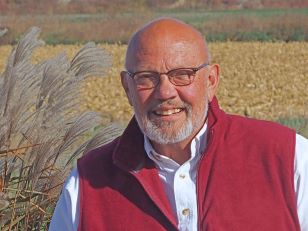When you’re a frequent cemetery wanderer, as I am, it’s impossible to miss the importance of someone’s having served in the military . Today, people put up all kinds of things around their loved ones’ stones, lights and mirrors and toys; but mostly all you know about whoever is buried beneath the stone is the years of his or her life and sometimes, maybe, a Bible verse. Spouses often share stones, but then again sometimes not. Sometimes a wanderer simply has to deduce who was married to whom–and who were the children.
What you can’t miss, today especially, is the flags or markers or whatever the Legion Auxiliary (or whoever) puts up on those sites that hold the mortal remains of men and women who served their country at war. They’re everywhere in red, white, and blue, often enough including rank and theater–“Sgt. Will Williams, U.S. Army, World War II, South Pacific.” Having served is huge in cemeteries.
I sometimes wonder what place my father’s war-time experience had in his memory, the years he spent in a tug, some of them way out in the South Pacific. Or what place the war plays in my father-in-law’s memory now, just a week or so before his 96th birthday. Once upon a time in the U. S. Army motor pool, he followed the Allied front from Normandy to Berlin, repairing tanks and jeep, anything with a motor. He was in the service for years, didn’t come home until The Bomb ended the war in the Pacific, where he was bound when it dropped. Hiroshima changed the course of history, but for him its blessing was more immediate–it brought him home.
I’ve heard him talk about his war experience, nothing bloody, but a trip through a goodly chunk of Europe that an Iowa farm boy could not have imagined he’d ever take. On Saturday, at the funeral of his sister-in-law, we went out to the cemetery along a road he said he and his little sister had walked plenty often, just about two miles into town to school. For a moment, I swear, I was back there, pavement gone, two ruts cut in the dirt, a mop-haired kid in bib overalls lugging a Karo syrup lunch bucket, mid-Depression, his little sister dallying behind.
It’s impossible for me to imagine that eighth-grade farm boy just a few years later as a grease monkey in fatigues and steel helmet, a monkey wrench in his hand as he works beneath some half-track somewhere in the dark woods of a German countryside. Or in England with tens of thousands of others Yankees, just waiting for a boat trip to Normandy.
What flashes does his memory create these days? How much of what he remembers arises from those years so incredibly far away, when every day and night he’d be working on M4 Shermans, an unimaginable job to a kid who plowed broad Siouxland fields with a team of horses he loved?
It had to be, without a doubt, the most unforgettable experience of his lifetime. What’s a wedding night compared to two years across Europe? He toured England, France, the Netherlands, and Germany, meals from a tin can. Sometimes I wonder if his closest friends in all of life weren’t the men with him under those jeeps, men he only rarely saw once he was came home, men he never forgot.
An uncle and an aunt of mine worked day and night putting soldiers back together. They were medics and saw more horror–my father used to say–than any man or woman should. How did the two of them take the fog of war once it was over. When my uncle came home, he worked as a barber, cutting men’s hair. What images of he knew and saw never brushed out of his memory?
All those cemetery markers, those little American flags, aren’t just a tribute but a reminder that some memories won’t be buried.
Just a couple days ago, I went up to a woman I’d interviewed for a story a decade ago. She and her husband had given me a tour of the country where they’d lived when they were married, a beautiful section of Sioux County. We drove on the yard of the house they walked into right after their wedding, in fact.
But last weekend she didn’t recognize me, didn’t know me at all. She’s well into her nineties. I asked her if she remembered showing me the home place ten years ago.
“We were in the underground, you know. My father went out. . .” and she started in on a story cobbled together from images out of control in her mind.
“We were with the underground, you know?” she said, three or four times, as if it were something that simply had to be documented. She was a girl in occupied Holland, and, for whatever reason, all she could could say came in shards of a story she couldn’t get straight. It was war, a memory of war.
On Memorial Day we honor those who served, whose memories are photo albums images the rest of us can not imagine. We put up flags on cemetery plots because, combat or motor pool or MASH tent, what those men and women went through, all of them, was something only they really know.
Truth be known, in just about every situation, those men and women were unlikely to have any more formative experience.
Walk through the cemetery down the road sometime, amble along the gravestones, and all you’ll ever know of hundreds of the deceased is when they were born, when they died, and whether they served in war.
There’s always more to the story, of course, but that’s all there is above ground, as if that’s all that shouldn’t be forgotten. And maybe that’s so.


